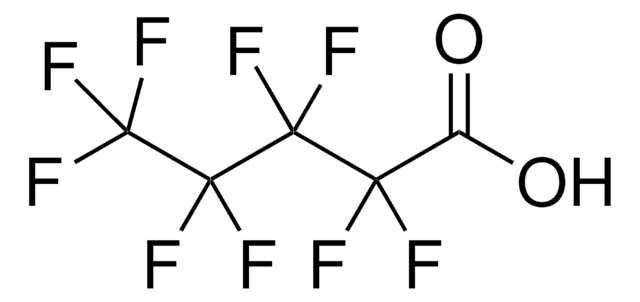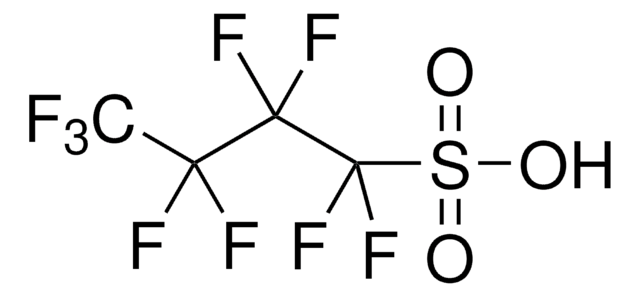177741
Perfluorodecanoic acid
98%
Sinónimos:
Nonadecafluorodecanoic acid, Nonadecafluorocapric acid, Perfluorocapric acid, Perfluorodecanoic acid
About This Item
Productos recomendados
vapor pressure
~10 mmHg ( 0 °C)
Quality Level
assay
98%
bp
218 °C/740 mmHg (lit.)
mp
77-81 °C (lit.)
solubility
methanol: soluble 10%, clear to very slightly hazy, colorless to faintly yellow
functional group
carboxylic acid
fluoro
SMILES string
OC(=O)C(F)(F)C(F)(F)C(F)(F)C(F)(F)C(F)(F)C(F)(F)C(F)(F)C(F)(F)C(F)(F)F
InChI
1S/C10HF19O2/c11-2(12,1(30)31)3(13,14)4(15,16)5(17,18)6(19,20)7(21,22)8(23,24)9(25,26)10(27,28)29/h(H,30,31)
InChI key
PCIUEQPBYFRTEM-UHFFFAOYSA-N
¿Está buscando productos similares? Visita Guía de comparación de productos
General description
Application
signalword
Danger
hcodes
Hazard Classifications
Acute Tox. 3 Oral - Carc. 2 - Lact. - Repr. 1B
Storage Class
6.1C - Combustible acute toxic Cat.3 / toxic compounds or compounds which causing chronic effects
wgk_germany
WGK 3
flash_point_f
Not applicable
flash_point_c
Not applicable
ppe
Eyeshields, Faceshields, Gloves, type P2 (EN 143) respirator cartridges
Elija entre una de las versiones más recientes:
¿Ya tiene este producto?
Encuentre la documentación para los productos que ha comprado recientemente en la Biblioteca de documentos.
Los clientes también vieron
Nuestro equipo de científicos tiene experiencia en todas las áreas de investigación: Ciencias de la vida, Ciencia de los materiales, Síntesis química, Cromatografía, Analítica y muchas otras.
Póngase en contacto con el Servicio técnico










